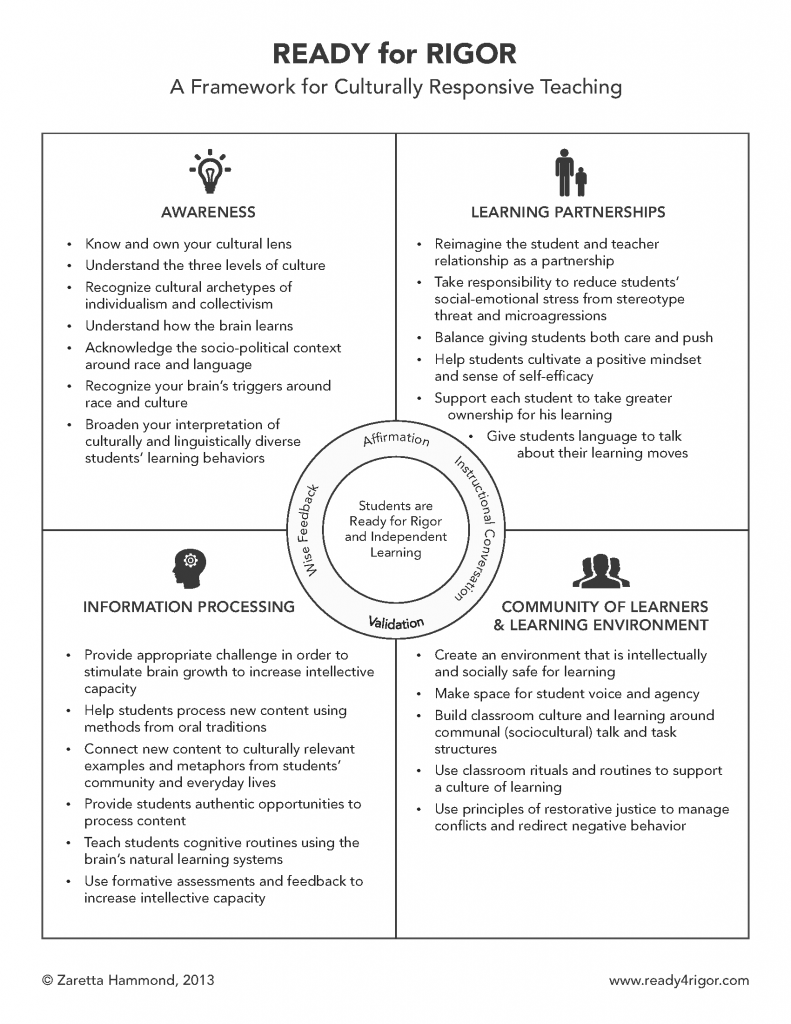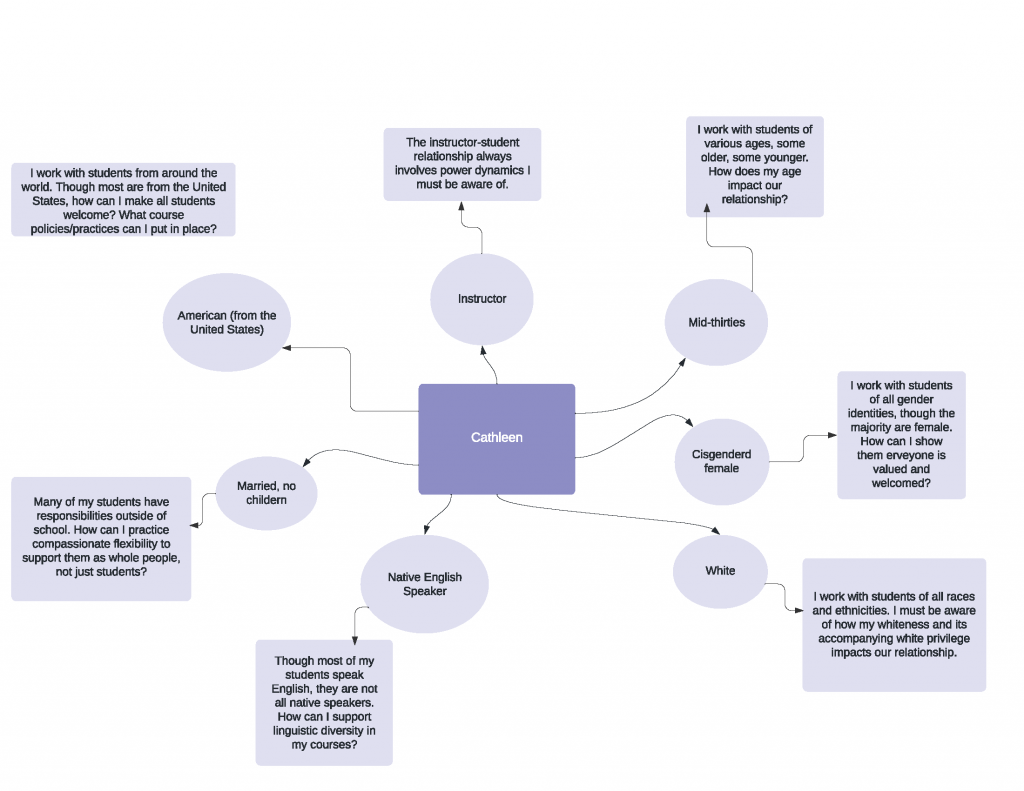Culturally Responsive and Inclusive Teaching: An Introduction
Welcome to the Inclusive Teaching module. We are delighted to have you join us as we work together to become more inclusive and culturally responsive practitioners.
There are three sections in this module that will help you learn about the importance of culturally responsive teaching and reflect on your own background and teaching practice. As we go through the module, we’ll develop action plans for increasing inclusion in our classes.
In this first section, we’ll focus on self-reflection, the demographics of our students, and work together to develop diversity and inclusion statements.
The objectives of the first section are:
- participants will describe the importance of culturally responsive teaching and its impact on student learning outcomes
- participants will construct a self-identity map and investigate how your identity intersects with students’ identities and impacts learning outcomes
- participants will critique several diversity and inclusion statements and determine which aspects resonate with them and their students
The Importance and Impact of Culturally Responsive Teaching
As we begin our exploration of culturally responsive teaching, let’s take a look at the impact these practices have on students and their communities. Watch the video below to learn how students feel about these practices in their own words. Though the video describes the impact of these practices in a K-12 context, it is still applicable for higher education.
What is Culturally Responsive Teaching?
Culturally Responsive Teaching has its roots in culturally relevant pedagogy, a concept developed by Gloria Ladson-Billings “to describe a form of teaching that calls for engaging learners whose experiences and cultures are traditionally excluded from mainstream settings” (Muniz, 2019). Geneva Gay developed this concept to focus on strategies for teaching and developed the term culturally responsive teaching. Culturally responsive teaching focuses on “using the cultural knowledge, prior experiences, frames of reference, and performance styles of ethnically diverse students to make learning encounters more relevant to and effective for them” (Gay, 2010). With Culturally sustaining pedagogy, a concept developed by Django Paris, “educators help students develop a positive cultural identity”, wherein “educators not only draw on but also sustain students’ culture” (Muniz, 2019).

Zaretta Hammond, educator and author of Culturally Responsive Teaching and the Brain: Promoting Authentic Engagement and Rigor Among Culturally and Linguistically Diverse Students, offers a framework for culturally responsive teaching that centers around four key aspects: awareness, learning partnerships, information processing, and the community of learners and learning environment (Hammond, 2013).
Review the graph below to learn more about each of the four aspects of culturally responsive teaching.

Competencies for Culturally Responsive Teaching
There are eight competencies for culturally responsive teaching.
Click the plus signs in the graphic below to learn more about each competency.
Image and text from Eight Competencies for Culturally Responsive Teaching [Graphic]. (2020) New America. https://www.newamerica.org/education-policy/reports/culturally-responsive-teaching/teacher-competencies-that-promote-culturally-responsive-teaching/
Reflection 1
One major aspect of culturally responsive teaching is establishing an environment in which students feel included.
This course is intended to help you build and strengthen your existing practice in their area. Respond to the prompt below to share how you are already engaging in this work. Click the checkmark in the lower corner to submit your answer.
Self-Identity Mapping
It’s now time to engage in the first main activity of this module: self-identity mapping. In this activity, we’ll each create a visual map of our identity.
Here is an example of an identity map.

Your Turn
Now that you’ve seen an example, take some time to create your own identity map. You can use paper and pencil or an online program. Spend about 15 minutes on this activity. As you create your map, consider the various aspects of your identity. How do those identities intersect? How do they work with or against each other?
Reflect
After you have finished your map, take a few moments to reflect on the following questions.
- How do your various identities intersect?
- Which identity do you think is perceived most when you work with students?
- How does your identity impact your work as an educator?
Student Demographics
Getting to know students is an essential step in creating a safe and equitable learning environment. If we seek to draw on students’ culture to shape curriculum and instruction and promote respect for student differences, we must know who students are.
Use the arrows to click through the slide show to learn more about the demographics of the University of Baltimore student population. Click the double-headed arrow in the lower right corner to expand the slide show for a larger size.
Reflection 2
Now that you’ve reviewed student demographics at the university, consider how your identities might intersect and interact with those of our students. Answer the prompt below.
Diversity and Inclusion Statements
Understanding how systemic bias and historic inequities impact our society is a life-long pursuit that requires ongoing commitment. While that is not the focus of this course, we hope that you will engage in this work.
One, albeit small, way to acknowledge this impact, can be to create a diversity and inclusion statement. You might already have a diversity and inclusion statement or be familiar with them.
A diversity and inclusion statement states your commitment to building an inclusive, diverse, and welcoming classroom space for students of all backgrounds. These statements can help create inclusive classes and make students feel safe.
These statements can vary in length, but for our purposes, we’ll focus on creating a statement that is one to two paragraphs that can be used in your syllabus or to open your course.
Examples
Before we write our own statements, let’s look at a few examples. Take some time to visit the links below. As you review the statements, consider what you like about them, what challenges you, and what you might change. Take notes or start a working document for your own statement if you encounter language that particularly resonates with you.
Now that we’ve reviewed a few sample statements, let’s draft our own. If you need help getting started, read an article by Tanya Golash-Boza on tips for writing a diversity statement (2016).
